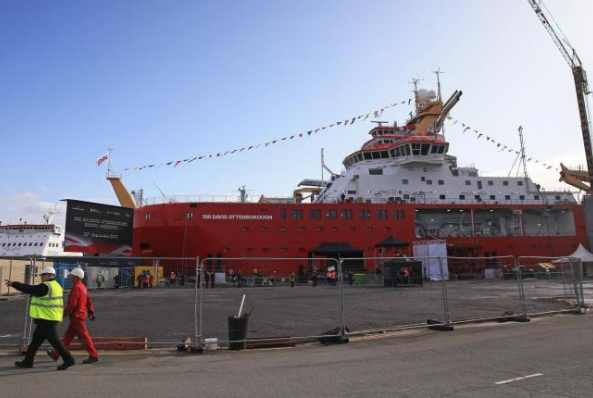The Duke and Duchess of Cambridge officially named the UK’s new polar research ship RRS Sir David Attenborough at the Cammell Laird shipyard in Birkenhead near Liverpool on Thursday.
The 93-year-old broadcaster and natural historian also attended the ceremony as did 200 children dressed as penguins.
The ship, which cost £200 million, is the largest commercial ship to be built in Britain for three decades and has been described as “a floating science lab”. As well as having cutting edge laboratories, the ship can also carry numerous freight containers meaning that it can resupply bases and expeditions in the field.
The 15,000-tonne vessel was launched in the River Mersey in July last year and will start undergoing sea and ice trials in the coming weeks.
The RSS Sir David Attenborough is officially classed as an ice breaker and should be able to plough through ice up to a metre thick at up to three knots.
The vessel, which was designed by Rolls Royce, is capable of nearly silent operating when required, meaning that scientists can study sea creatures without disturbing them.
Another unique feature of the ship is so-called ‘moon pool’, a hole running right through the middle of the hull that allows instruments to be lowered into and lifted out of the sea when stormy weather or thick sea ice prevents this being done by cranes from the side or back of the ship.
The ship will be funded and operated by the British Antarctic Survey, which is part of the National Environment Research Council (NERC). It has a range of 19,000 nautical miles and requires a crew of 30 to sail her.
Boaty Mcboatface
In an online poll the public had suggested that the pride of British science should be called ‘Boaty McBoatface’ in what was apparently a rather poor joke, until ministers stepped in and decided that the new vessel should be called Sir David Attenborough.
However, the long range yellow robotic submarine that is carried by the Attenborough is now called Boaty Mcboatface. The submarine will carry out research in environments where the Attenborough is not able to go such as under deep polar ice caps.
The autonomous underwater vehicle (AUV) is capable of creating a 3D map of deep ocean waters and has already discovered that turbulence as a result of changing wind patterns is causing warmer water to mix with colder, denser water at greater depths.
Sir David Attenborough himself speaking to BBC Radio 4’s Today programme just before the naming ceremony said that the public are now finally starting to understand the dangers posed by climate change.
“I’d much rather do a programme saying everything is wonderful – but its not. The penny took a long time to drop, but it is starting to now,” he said.
Prince Harry, on an official visit to Botswana in an interview with CNN backed Greta Thunberg and all other climate activists in their actions.
“It is an emergency, a race against time and one in which we are losing. I don’t think that there is anyone in this world that can deny science. Undeniable science and facts. No one can deny science otherwise we will live in a very troubling world,” he said.
Photo from News and Star
- Why is California So at Risk from Wildfires? - 13th November 2019
- Carbon Offsetting is Growing but Does it Make a Difference? - 11th November 2019
- Three Confirmed Dead as Australia Prepares for “Catastrophic” Bushfires - 11th November 2019






